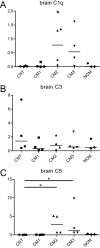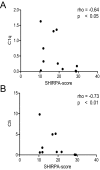Complement factors C1q, C3 and C5 in brain and serum of mice with cerebral malaria
- PMID: 18847493
- PMCID: PMC2572067
- DOI: 10.1186/1475-2875-7-207
Complement factors C1q, C3 and C5 in brain and serum of mice with cerebral malaria
Abstract
Background: The patho-mechanisms leading to brain damage due to cerebral malaria (CM) are yet not fully understood. Immune-mediated and ischaemic mechanisms have been implicated. The role of complement factors C1q, C3 and C5 for the pathogenesis of CM were investigated in this study.
Methods: C57BL/6J mice were infected with Plasmodium berghei ANKA blood stages. The clinical severity of the disease was assessed by a battery of 40 standardized tests for evaluating neurological functions in mice. Brain homogenates and sera of mice with CM, infected animals without CM and non-infected control animals were analyzed for C1q, C3 and C5 up-regulation by Western blotting.
Results: Densitometric analysis of Western blots of brain homogenates yielded statistically significant differences in the levels of C1q and C5 in the analyzed groups. Correlation analysis showed a statistically significant association of C1q and C5 levels with the clinical severity of the disease. More severely affected animals showed higher levels of C1q and C5. No differences in complement levels were observed between frontal and caudal parts of the brain. Densitometric analysis of Western blot of sera yielded statistically lower levels of C1q in infected animals without CM compared to animals of the control group.
Conclusion: The current study provides direct evidence for up-regulation of complement factors C1q and C5 in the brains of animals with CM. Local complement up-regulation is a possible mechanism for brain damage in experimental cerebral malaria.
Figures




Similar articles
-
Predictive value of serum anti-C1q antibody levels in experimental autoimmune myasthenia gravis.Neuromuscul Disord. 2006 Feb;16(2):137-43. doi: 10.1016/j.nmd.2005.11.005. Epub 2006 Jan 19. Neuromuscul Disord. 2006. PMID: 16427283
-
Apoptosis in experimental cerebral malaria: spatial profile of cleaved caspase-3 and ultrastructural alterations in different disease stages.Neuropathol Appl Neurobiol. 2007 Oct;33(5):560-71. doi: 10.1111/j.1365-2990.2007.00833.x. Epub 2007 Apr 18. Neuropathol Appl Neurobiol. 2007. PMID: 17442059
-
Plasmodium berghei: cerebral malaria in CBA mice is not clearly related to plasma TNF levels or intensity of histopathological changes.Exp Parasitol. 2000 May;95(1):1-7. doi: 10.1006/expr.2000.4508. Exp Parasitol. 2000. PMID: 10864512
-
Pathogenic T cells in cerebral malaria.Int J Parasitol. 2006 May 1;36(5):547-54. doi: 10.1016/j.ijpara.2006.02.007. Epub 2006 Mar 10. Int J Parasitol. 2006. PMID: 16600241 Review.
-
Immunopathogenesis of cerebral malaria.Int J Parasitol. 2006 May 1;36(5):569-82. doi: 10.1016/j.ijpara.2006.02.016. Epub 2006 Mar 20. Int J Parasitol. 2006. PMID: 16678181 Review.
Cited by
-
Azathioprine favourably influences the course of malaria.Malar J. 2009 May 14;8:102. doi: 10.1186/1475-2875-8-102. Malar J. 2009. PMID: 19442289 Free PMC article.
-
Anti-malarial effect of gum arabic.Malar J. 2011 May 20;10:139. doi: 10.1186/1475-2875-10-139. Malar J. 2011. PMID: 21599958 Free PMC article.
-
Pharmacokinetics and Pharmacodynamics of a Nanostructured Lipid Carrier Co-Encapsulating Artemether and miRNA for Mitigating Cerebral Malaria.Pharmaceuticals (Basel). 2024 Apr 6;17(4):466. doi: 10.3390/ph17040466. Pharmaceuticals (Basel). 2024. PMID: 38675426 Free PMC article.
-
Interaction Between the Complement System and Infectious Agents - A Potential Mechanistic Link to Neurodegeneration and Dementia.Front Cell Neurosci. 2021 Aug 2;15:710390. doi: 10.3389/fncel.2021.710390. eCollection 2021. Front Cell Neurosci. 2021. PMID: 34408631 Free PMC article. Review.
-
A rapid murine coma and behavior scale for quantitative assessment of murine cerebral malaria.PLoS One. 2010 Oct 1;5(10):e13124. doi: 10.1371/journal.pone.0013124. PLoS One. 2010. PMID: 20957049 Free PMC article.
References
-
- Belnoue E, Kayibanda M, Vigario AM, Deschemin JC, Van Rooijen N, Viguier M, Snounou G, Renia L. On the pathogenic role of brain-sequestered alphabeta CD8+ T cells in experimental cerebral malaria. J Immunol. 2002;169:6369–6375. - PubMed
Publication types
MeSH terms
Substances
LinkOut - more resources
Full Text Sources
Miscellaneous

